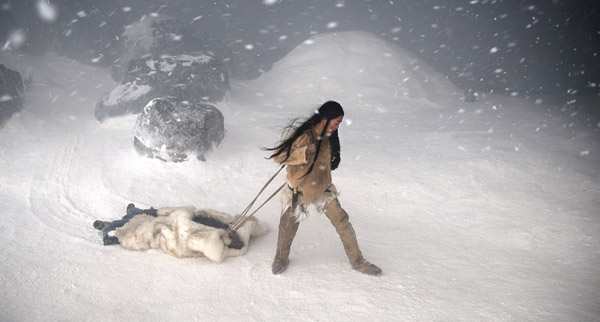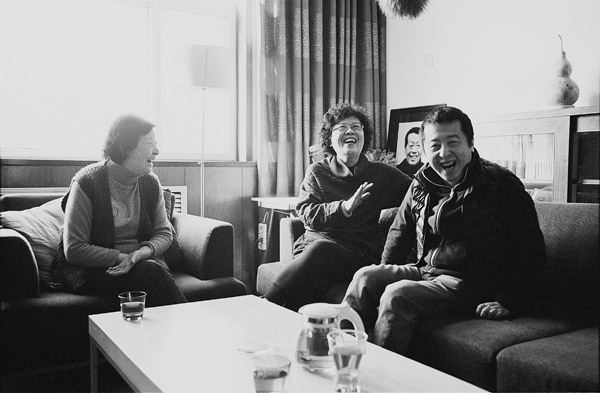Tomorrow, the Berlinale will premiere new films by Jafar Panahi, Werner Herzog and Andrew Haigh. In the days that follow, there’ll be new work from Terrence Malick, Patricio Guzmán, Pablo Larrain, Alexey German Jr., Radu Jude, Peter Greenaway—and that’s just the Competition (for a brief overview of highlights in the other programs, I recommend Giovanni Marchini Camia‘s preview for Filmmaker). Today, however, we’re stuck with the festival opener, Isabel Coixet’s Nobody Wants the Night.
I won’t pretend to have the first idea as to how the selection committee goes about choosing what to show on opening night. All those big guns in the lineup and they reach for this clunker to set the stage for the 65th edition? I’ll venture three wild and uninformed guesses. First, the Berlinale needs a star to walk the red carpet to the Opening Gala, and they’ve got one in Juliette Binoche (at the same time, of course, the Herzog and Malick films are lousy with stars). Second, Coixet and the Berlinale go way back. The festival’s screened six of her films before this one and, in 2009, she served on the International Jury. Third, back to the red carpet and the profile the Berlinale hopes to present to the world: A Spanish director—a woman!—a French star (Binoche), Japanese actress Rinko Kikuchi and the Irish Gabriel Byrne. Festival director Dieter Kosslick is known to think along these lines, but again, I’m just guessing.
Critics have been tough on Coixet in the past, often for good reason, but I’d stick up for My Life Without Me (2003) and Elegy (2008) and particularly for the performances she coaxed from Sarah Polley, Mark Ruffalo and Scott Speedman in the former and Penélope Cruz and Ben Kingsley in the latter. Unfortunately, in Nobody Wants the Night, Binoche gives her most ill-judged performance since the disaster that was John Boorman’s In My Country in 2004. We might wonder if she simply isn’t capable of nuance in English, but her work for Abbas Kiarostami in Certified Copy (2010) proves that she certainly is. Then there’s Rinko Kikuchi, last seen trudging through the snow in David and Nathan Zellner‘s beautiful Kumiko, the Treasure Hunter, as an Eskimo. If anyone talks at all about Nobody Wants the Night once the festival is over, this casting decision might be a sticky talking point. Meanwhile, poor Gabriel Byrne has nothing but a stock character to work with, the white man gone half-native who warns our naive heroine that she knows nothing of this raw wilderness and its people.
Coixet tells Pamela Rolfe in the Hollywood Reporter that she “was totally fascinated” by the “stark and mysterious beauty of the script.” To be fair, the story takes a turn a little over halfway through that does make for a more engaging hour or so than all the cumbrous gear-grinding of the first half. Whatever isn’t made absolutely clear in the naked exposition of the dialogue is punctuated by unnecessary voiceover. Binoche’s Josephine practically delivers a PowerPoint presentation outlining her determination to meet up with her husband, explorer Robert Peary, on his 1908 expedition to the North Pole. And a disembodied voice tells us that, yes, her furious love for Robert Peary is most definitely our protagonist’s motivation. Again, the long stretch in the second hour, with dialogue between the “civilized white woman,” as she calls herself, and Kikuchi’s Eskimo stripped to its bare essentials, has its moments, but once a third party, fluent in English, arrives, it’s right back to overstating the obvious.
WHAT OTHERS ARE SAYING
For the Playlist‘s Jessica Kiang, this is “a film that falls exactly in the blind spot between ‘mediocre’ and ‘outright bad.’ But it has deeply earnest intentions, and occasionally, like a snowblind, starving person in a blizzard tripping over a carcass, it stumbles on a moment of meatiness. But the script is so unsure of itself and Coixet’s direction so uneven that whenever it threatens to find its way, it pretty soon loses it again.”
“There are too few instances where all of the film’s different elements come together to deliver any kind of visceral charge,” finds Boyd van Hoeij in the Hollywood Reporter. “If Binoche and Kikuchi (the latter boxed in by her character’s limited dialogue) didn’t have a generally convincing love-hate rapport, the film would have been a very cold affair indeed.”
In Variety, Guy Lodge finds the film to be “dramatically as pallid and lifeless as the frozen tundra on which it takes place, burdened with a hokey romanticism that doesn’t complement its quasi-feminist purview.”
“At times Nobody Wants the Night brings to mind a film by Peter Weir, with its aerial shots of white landscapes and mountains,” writes Alfonso Rivera, who also interviews Coixet for Cineuropa. “At others, any one of the characters could be rescued from one of Werner Herzog’s mad adventures. But the distinguished Coixet clearly illustrates like blood sprinkled on the purest of ice: where those two determined, romantic and brave women are, their dreams will progressively fall apart the closer they get to them, opening themselves up to different realities.”
The Guardian‘s Kate Connelly reports on the press conference.
Updates: For Kevin Lee at Indiewire, “Coixet’s unfocused direction and Binoche’s grating performance waste little time sending this cinematic iditarod off-course.”
At the Film Stage, Giovanni Marchini Camia notes that “the cinematography takes surprisingly little advantage of the spectacular nature (the film was partly shot in Norway). What little is shown of the landscape is primarily done through insert shots, whose differing texture seems to indicate that they were sourced elsewhere. By portraying the characters in close-up most of the time, the film has difficulty generating a sense of danger and adventure, so that when the mission does inevitably run into trouble, lives are lost with little impact. The insistent string and piano soundtrack that kicks in at any critical instance—and, even more regrettably, during any consequential conversation as well—does little to make up for the lacking momentousness.”
Update, 2/11: More from Shelagh Rowan-Legg (Twitch); Eric Eidelstein interviews Binoche for Indiewire.
Walter Salles’s documentary Jia Zhangke, A Guy from Fenyang premiered in Rome as a work-in-progress and now screens in the Berlinale’s Panorama program. It begins as a pleasant tour through Jia‘s hometown hosted by the renowned Chinese filmmaker himself. The all-brick residential area where Jia grew up is nearly as bare as it appears in Jia’s early works, Xiao Wu (The Pickpocket, 1997) and Platform (2000), but once Jia meets up with his old friend Wang Hongwei, who plays lead characters in both films, and the pair heads out onto busier streets, the two begin pointing out all the changes. The karaoke bars are gone and, in general, the town’s just not as lively as it once was.
A friend of Jia’s father recognizes the filmmaker and excitedly asks to have his picture taken with him—the first of many signs throughout the film that, for all the problems his films have had making their way through official distribution channels (including and perhaps especially A Touch of Sin [2013], which, while it hasn’t been outright banned, has also not seen a proper release, a particular sore point toward the end of Salles’s doc), Jia is practically a celebrity in China.
Jia visits his mother and sister; his crew and other actors, including Zhao Tao, whom Jia eventually married, chat about what it’s like to work with him; relatives talk about racing to the TV whenever Jia’s on; and it’s all very nice and nothing out of the ordinary—until at some point you realize that scenes and segments are beginning to take on emotional heft. Once Salles has familiarized his audience with the characters and circumstances of what for most will be an unfamiliar milieu, he gets Jia to talk about what’s really on his mind.
And we learn that, of all the films he’s made, it’s Platform that he seems to be most invested in personally. Jia recalls showing this portrait of a generation, following a group of friends from 1979 to that decisive year, 1989, to his father, and the memory triggers a recollection of the day Jia learned that his father, whose life was shaped by Mao’s Cultural Revolution, was dying. “He didn’t have many happy moments in his life,” says Jia, choking back tears.
Jia is currently considering recutting Platform and perhaps even making a sequel. With his crew, he discusses these and other plans as well as the likely challenges they’ll have to overcome to realize them before Salles slides us into a New Year’s party and a rousing toast: Onward.
WHAT OTHERS ARE SAYING
“From the wandering social realism of his early Shanxi Province trilogy to his journalistic documentary work to the more violent, wuxia-colored cri de coeur that was 2013’s A Touch of Sin, Jia’s films are bound by an elegiac concern for the shifting infrastructure, cultural blind spots and socioeconomic constraints of contemporary China,” writes Guy Lodge for Variety. “Salles’s film follows suit, finding the filmmaker in dryly good-humored but decidedly anxious form… ‘We live in a time of confused values and national malaise,’ Jia observes wearily. His own sense of personal malaise, meanwhile, is put in more visceral terms: ‘My guts are messed up,’ he mumbles, between cigarette drags.” Let’s note, too, that doctors are keeping an eye on Jia’s heart palpitations.
“What Salles (and his fellow interviewer, the French critic Jean-Michel Frodon) reveal in A Guy from Fenyang is a man on fire,” writes Clarence Tsui in the Hollywood Reporter. “Beneath the meek veneer (in his exchanges with his family and his nouveau riche high-school buddies) and the mild manners is a filmmaker still seeking a way to make films about all the drastic changes unfolding around him… Looking back at it in a few years’ time, A Guy from Fenyang will eventually be as useful a record about a filmmaker’s life as Olivier Assayas‘s 1999 documentary about Hou Hsiao-hsien—who remains, after all, one of Jia’s key sources of inspiration.”
Update, 2/15: At the House Next Door, Kenji Fujishima asks “where else will you see this deeply engaged and endlessly curious artist reacting to firecrackers heard in the distance with rapture, eloquently explaining the sense of possibility he hears in those booming noises?”
Update, 2/21: “It’s an illuminating portrait, respectful of its subject’s importance as an artist but never po-faced,” writes BFI programmer Geoff Andrew. “As a tribute from one filmmaker to another, it’s quite exemplary.”
In other Berlinale news today, Daniel Kasman has begun his correspondence with Adam Cook in the Notebook. And the Festivalists have launched a video series, Critic’s Choice. First up, Beatrice Behn.
For news and tips throughout the day every day, follow @KeyframeDaily. Get Keyframe Daily in your inbox by signing in at fandor.com/daily.





